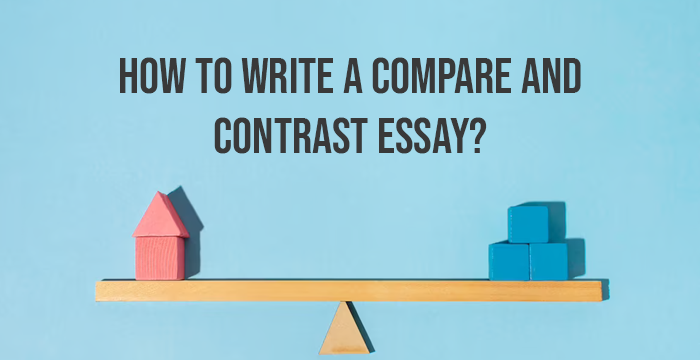
Compare and contrast is an essay type that distinguishes between two concepts, theories, ideologies, themes, etc. by stating the similarities and the differences between the two. It requires in-depth knowledge on both the areas. It is used to examine the concepts that are held apart due to misconceptions or unnecessarily tied together. The essence of compare and contrast in essay lies in analysing the ideas in detail and marking out unexplored comparisons and differentiations besides the obvious ones. Structuring is at the apex in this type of essay and requires a conscientious approach. If you get a basic understanding of technical aspects, a comparing and contrasting essay can be in fact fun and interesting as it giggles the brain and improves analytical abilities.
How to write a Compare and Contrast essay?
We have designed a step-wise process of writing compare and contrast essays to make your writing easier and hassle-free.
1. Select a topic:
The first step to writing a brilliant compare and contrast essay is to choose a sensible topic. See for concepts or ideas that are confused with each other or thought of as two ends of a sea. Remember that both should have reasonable common points and differentiating factors although one of them can outweigh. For instance, a topic can have more similarities than differences but ensure that it has a sizable amount of differences else the reader will question your choice of topic in the first place. Here are a few topic ideas for your reference:
- Socialism vs communism
- Nazism vs fascism
- India- pre-independence and post-independence
- Use of surrealism: Thomas Mann vs Franz Kafka
- AI: Blessing or a curse
- Indian superheroes vs western superheroes
- Steve Jobs vs Bill Gates
- Buddhism and Jainism
- Internet in education: a facilitator or destroyer
2. List down similarities and differences:
After you have selected a topic, think about the comparing and contrasting points between the two. A few obvious aspects will hit the mind first, jot them down. Now, remember that the ideas that are enlightened in your mind immediately will cross the reader’s mind also. The key is closely analysing the topic and identifying some unexpected similarities or differences that will make the reader go “Aha! Good one.” Open a random page of your book and make two columns titled similarities and differences. List the relevant points in each. If you are a creative nerd, draw Venn diagrams for the purpose. The aim is to get things sorted and have a skeleton on which you will build your essay.
3. Decide on the style of organisation:
Arrangement gains an upper hand in compare and contrast essays. This is because it has many elements to be incorporated viz. Details, evidence, facts and figures, definitions, comparing and contrasting aspects between ideas, etc. It is possible to slip out of the flow while writing which can leave the reader puzzled. For infusing clarity in the essay, there are three ways to organise your article:
a. Alternating Method:
In this technique the essay is drafted in a point-by-point manner. A paragraph is based on a broad general idea and both the parts of the topics are discussed consecutively one after the other pointing to similar and contrasting elements. It is advisable to opt this method when there are plentiful same and different points to discuss.
b. Block Method:
In the block method one paragraph revolves around one subject on one side and the next paragraph will discuss the next subject centering on the other side. Each paragraph gets its own subject here unlike the previous method where both the sides are simultaneously addressed in the same paragraph. It is useful for long research papers.
c. Similarities and Differences Method:
This is a simpler style of presenting where all the similarities between the two concepts are written first followed by all the differences (or vice versa). Use this technique of arrangement.
If you want to build up to a significant conclusion or revelation.
4. Start writing the essay:
Once the groundwork is done it won’t be tough to compose the article. The essay outline of compare and contrast essay includes typical introduction, body and conclusion sections. Give a brief background of the subject in introduction, lay down details, facts, findings, etc in body paragraphs and summarise the subject matter in the conclusion reiterating its importance.
5. Edit and proofread:
Conduct editing to find out where language can be improvised, whether anything is repeated or missed and analyse the transitions between paragraphs. Proofread for grammar, spelling and punctuation. Even minor touches can elevate the quality of your article and push up the grades.
Structure of Compare and Contrast essay:
Compare and contrast essay outline consists of a three part structure of beginning, middle and end. The pattern will vary depending upon the style of arrangement you choose. Let’s explore each part of the essay:
1. Introduction
How to start a comparing and contrasting essay requires deep knowledge of the subject and few tactics of composing a good introduction. Hook, background and thesis statement make for components of an appropriate introductory paragraph. A hook is the opening sentence meant to attract the audience towards the essay. A question, strong assertion and anecdote are suitable hook options for compare and contrast essays. Next write a short background of the topic you are elaborating on. Finally draft a powerful thesis statement around which your essay will revolve. It should be striking and can pronounce the significance of your subject. In longer thesis papers the introduction can showcase the stepwise overview of your content. Keep the introduction clear and concise.
2. Body:
After writing a compelling introduction, move on to the body paragraphs which constitute the major chunk of your essay. As per the style you pick, your paragraphs will be constructed. The essential elements of paragraphs are topic sentences followed by information and evidence and transition sentences. Topic sentence is the central idea of the paragraph and transition sentences are written at the end for proceeding effortlessly to the next subject. You can add points from research, statistics, quotes and personal interpretations too. Use connecting words and phrases like similarly, the same as, as opposed to, against it, likewise, unlike, departing from, by comparison, on the other hand, whereas, etc.
3. Conclusion:
The conclusion of the compare and contrast essay is the recap of the essay. Restate main claims and emphasize the importance of your thesis. Justify your thesis statement at the end. The conclusion should establish the central idea of your paper in the reader’s mind.
By now, you have an extensive knowledge of writing an effective compare and contrast essay from how to start a comparison essay to using an apt structure and tips for conclusion. Choose a relevant and relatable topic. Dig deeper into the topic and see whether you can offer any novel aspects in it. Proceed with a definite style of arrangement to enhance presentation and readability. Devise a rough plan and jot down all the pointers you can think of. Provide enough support for your claims and ensure objectivity in your write-up. End with an impactful conclusion. Read, reread and proofread before submitting. Once you begin, comparing and contrasting is indeed a cool activity which can be done with ease and fun. All the best!


